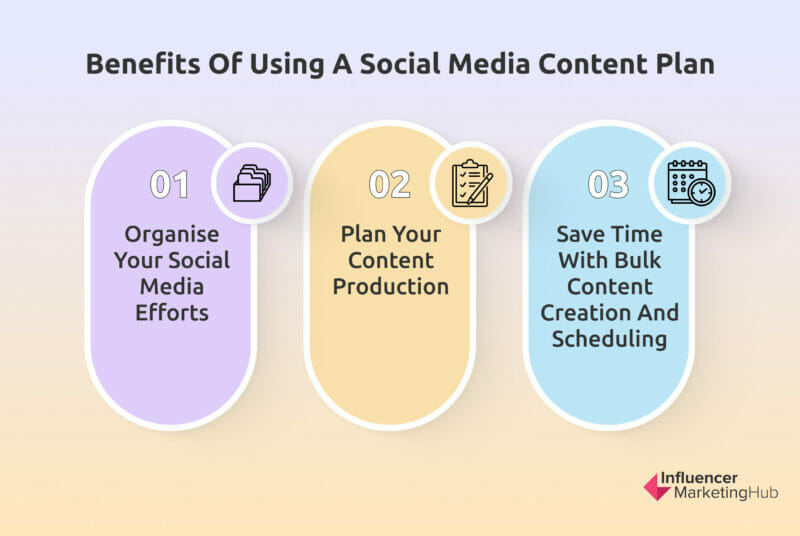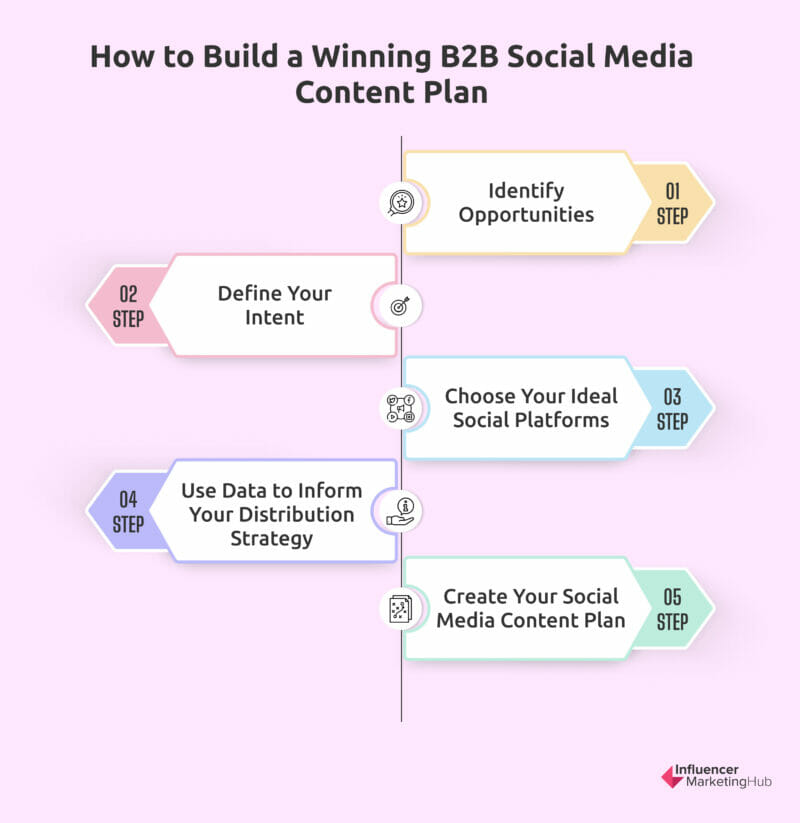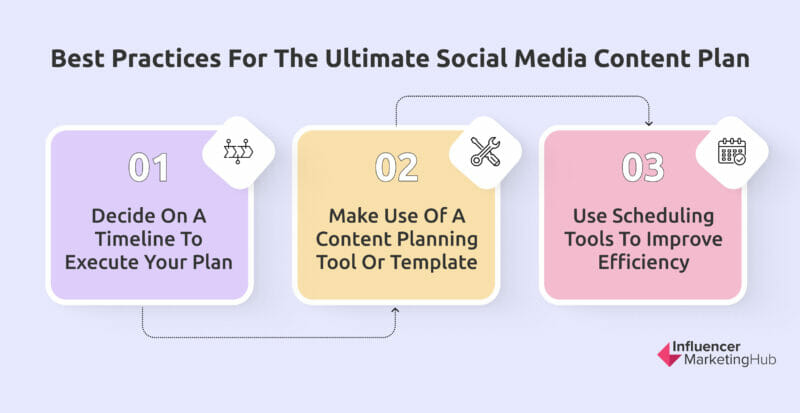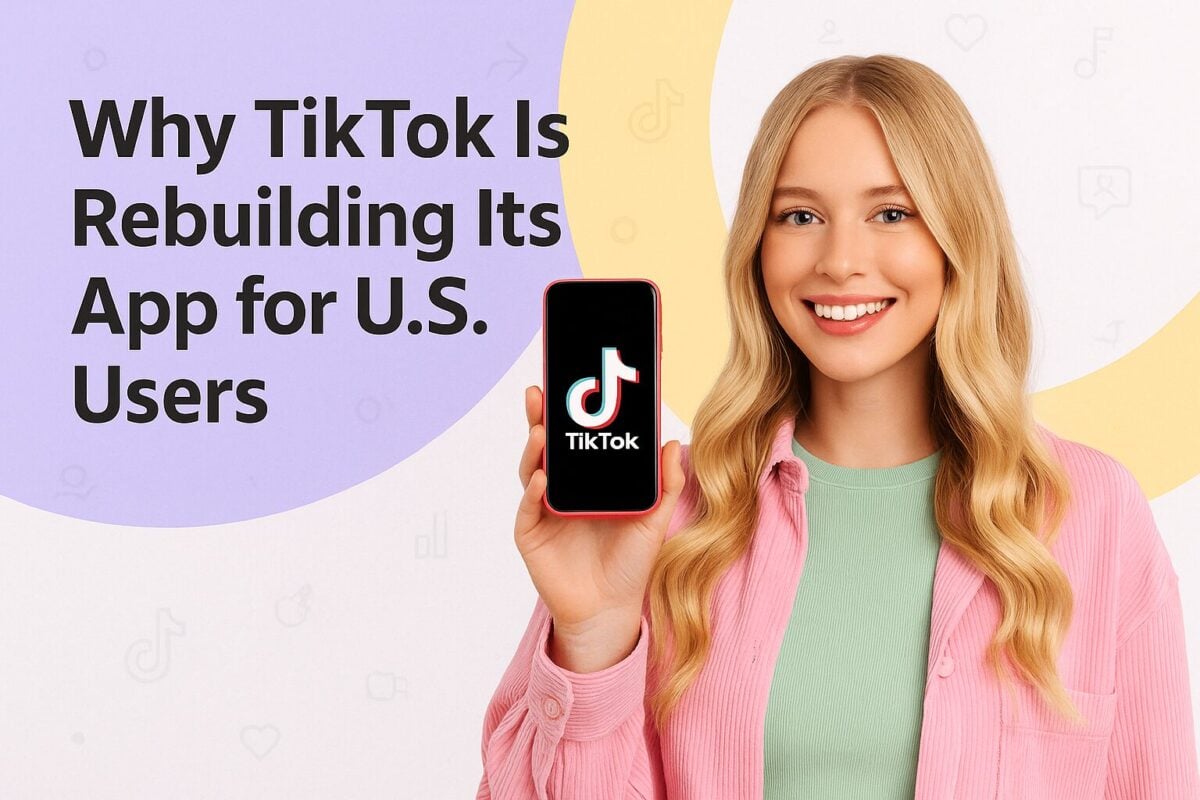Using social media for marketing isn’t just about posting whatever you want whenever you want to. With 4.62 billion social media users worldwide, you can no longer afford to keep social media marketing on the back burner.
This is even more crucial for B2B companies, as they need to appeal to an audience primarily made up of professionals and other business owners. To effectively connect with your target audience and maintain a strong brand presence, a strategic approach is essential. This involves having a well-defined plan that outlines what content to post and how to distribute it effectively.
So how do you create a B2B content plan for social media? This guide will walk you through the step-by-step process of developing a social media content plan tailored to your B2B business. Let’s take a look.
What is a Social Media Content Plan?
A social media content plan is the overarching strategy used by businesses to map out how they will leverage content to achieve social media success. The plan includes details such as which platforms to use, what content to create, when content should be published, and how the content will be distributed. It may also include best practices that must be followed across the organization so everyone’s in the loop about what they need to do and how it needs to be done.
B2B vs. B2C Content Plan: What’s the Difference?
On a broad level, a B2B content plan and a B2C content plan are essentially the same things–a well-laid out plan for creating and distributing content but for different types of businesses. However, upon closer look, there’s a clear difference in the intent of the said content plan. A B2B content plan will mainly focus on building authority through thought leadership content. Meanwhile, a B2C content plan will be more focused on other goals such as establishing quality or cost-effectiveness.
Additionally, the specifics of the content will vary since the target audience is largely different. For example, there will be differences in the distribution channels they want to target. While a B2B content plan will likely include platforms like LinkedIn, there’s no way for a B2C brand to reach its target audience through the same platform.
Benefits of Having a Social Media Content Plan
Regardless of whether you’re creating a social media content plan for a B2B or a B2C business, the benefits will more or less be the same. Here are some of the main reasons why you need a B2B content plan for social media.
Organize Your Social Media Efforts
First things first, having a proper content plan allows you to take a more organized approach to social media. It allows you to execute your strategy more effectively to achieve your social media goals.
From the type of content you want to post to the frequency of posting, you can organize everything ahead of time. Similarly, you can also delegate tasks more easily according to your content plan. This makes it easier for everyone in the organization to coordinate and work toward a specific social media goal.
Plan Your Content Production
One of the key advantages of developing a social media content plan is that it allows you to plan ahead for your content production. Since you already have a fair idea of what types of content you want to produce and at what frequency, you can plan your topics and content formats in advance. Having a social media content calendar usually comes in handy for this as it lets you map out your production schedule more efficiently.
With the freedom to plan ahead, you can anticipate future events and plan your production accordingly. For instance, you may be able to plan timely content for events such as annual holidays and occasions such as Thanksgiving and Halloween. Similarly, if there’s an upcoming industry event, you’ll be able to plan relevant content for it.
Save Time with Bulk Content Creation and Scheduling
Since your topics and content formats area already mapped out, you can also create your content in bulk ahead of time. This means you get to create content for the entire week or month based on your content plan. So you can set aside a time slot for content production and finish everything in advance instead of having to create new content every time.
Further, you can even schedule your pre-created social media posts to go out at a designated time. Use a social media scheduling tool to upload your posts and set a time to send them out. That way, you can free up your time to focus on other important tasks. Plus, you won’t ever forget to share timely posts or miss important events and dates.
How to Develop a B2B Content Plan for Social Media
Based on what you see so far, you can clearly understand the value of creating a social media content plan for your B2B organization. So if you’re ready to get started, here are some of the key steps you need to take.
Step 1: Identify Opportunities
Before you even begin to think of what content you want to post, it’s important to know where you currently stand. Start by taking stock of your existing content, social media accounts, and strategy (or lack thereof). This will help you identify any missed opportunities or any areas where your brand is lagging behind. Additionally, you’ll be able to determine what you need to focus on.
From your existing content, is there anything you can repurpose for your new content plan? Making the most of existing content assets will help you save time and resources in content production. For example, perhaps there’s a blog article you can turn into a short infographic to share on your socials, which will help you promote the article in turn.
What’s missing in your current posting strategy? Are you posting too frequently or not enough? Or perhaps you’re not following a specific posting frequency and basically posting whenever you have the time. As a result, you’re noticing low visibility and engagement for your social media accounts.
Make a list of all these issues to help you better understand what opportunities you have to grab. For example, in case of the last scenario, there’s an opportunity to maintain a regular posting schedule by creating content ahead of time and using scheduling tools.
Step 2: Define Your Intent
Now that you’ve identified the opportunities you’re missing, it’s time to get specific with what you want to accomplish. How will your social media content plan serve you? How will it ultimately contribute to your overall social media goals? This will make it easier to map out the type of content you should produce.
For most B2B organizations, social media serves as a channel to establish authority in their respective industries. As such, the focus usually is on thought leadership-type content. To fulfill this intent, they may share articles from their blog, publish valuable how-to content, and conduct interviews through live video broadcasts.
Step 3: Choose Your Ideal Social Platforms
Next, you need to decide which social media platforms will be helpful for accomplishing your intent and your overall social media goals. Think of the differences between each social media platform in terms of target audience and content format as well as its paid advertising tools. Then consider how those factors will subsequently play into your overall strategy so you can narrow down the best platforms to focus on.
Facebook and LinkedIn may be the first platforms that come to mind when it comes to B2B. However, they may not necessarily be the top platforms for every B2B company. For instance, Reddit may be a lesser-used platform that may prove to be highly valuable for your business depending on the goal you wish to accomplish.
According to Statista, LinkedIn is the most important social media platform for B2B marketers followed by Facebook. Surprisingly, although more consumer-focused, Instagram makes it to the top three.
Step 4: Use Data to Inform Your Distribution Strategy
The next part is where you can begin to solidify your social media content plan a little bit more. It involves looking at the past performance data of your social media content to see what works and what doesn’t work. The data can be used to inform your content distribution strategy and ensure its efficacy. At the most basic level, you’ll want to collect data about posting frequency, timings, and number of posts.
For example, you’d want to take a look at your posting frequency and see if you’re currently getting enough engagement. If not, you might want to ramp up the frequency and share more posts in a day. Or you might notice that you tend to get a high level of engagement for posts that go out at a specific time of day. You can then replicate this by scheduling more posts to go out around this time.
Step 5: Create Your Social Media Content Plan
Finally, it’s time to put together all these details into a documented content plan for your social media. This basically involves putting together the info in a shareable document so you can easily access it and share it across the organization.
Outline all the details about your goals and how you plan to accomplish them. You’d want to include the following key details:
- Target social media platforms
- Brand social media handles
- Publishing and distribution plan
- Content creation process
- Publishing workflow
- Key content formats
- Posting frequency and schedules
- Team responsibilities
- Content creation and publishing tools
- Measurement strategy and metrics
Tips and Best Practices for Creating a Social Media Content Plan
Now that we’re clear on the process of creating a social media content plan, you may be eager to start. However, keep the following tips and best practices in mind to maintain efficiency and better develop your content plan.
Decide on a Timeline to Execute Your Plan
Having a clear timeline in place will help you execute your plan in a timely manner and organize your efforts. Before you start using the content plan, make sure to establish timelines and milestones to accomplish certain tasks. Clearly outline how long you’ll carry out the new publishing strategy, when you’ll collect performance reports, and when you’ll share your findings. Similarly, give yourself a timeline for implementing your data insights to finetune your strategy.
So for example, you might consider starting with a two-week publishing cadence and then reporting on your performance. You can then share your findings with relevant stakeholders at a specified time. Then give yourself about a week to incorporate feedback and improve on your strategy.
Make Use of a Content Planning Tool or Template
Using a tool with content planning capabilities is crucial for organizing your efforts and improving efficiency. These tools typically come with a content calendar that you can use as a template to plan your posts and topic ideas. Alternatively, others may also choose to keep a separate spreadsheet for organizing and sharing content ideas before they’re ready to be added to your content planning tool.
Moreover, they offer visibility across the organization so everyone in your team can see what’s going on. They even let you collaborate on your content plan by getting team members to contribute. You can assign tasks to specific team members, so everyone is clear on their responsibilities and what is expected of them.
Use Scheduling Tools to Improve Efficiency
Finally, make sure to use a scheduling tool that will send you reminders or even automatically publish your posts on your behalf. These tools make it easier to maintain your target publishing frequency since you don’t have to manually push out your posts. Instead, you can set a time for when a specific post is supposed to be published, and the tool will automatically send it out to your chosen social media channels.
Get Ready for Effective B2B Social Media Content
When you have a well-established social media content plan, your B2B marketing efforts become more organized. You can ensure that your social media efforts are strategic and intentional, which is essential for delivering results. Make the most of our guide and tips to get started with your B2B social media content plan.
Frequently Asked Questions
What should B2B post on social?
Besides owned content, B2B brands should share industry-related articles from third-party sources and thought leadership content.
What should be included in a social media content plan?
A social media content plan should include details like content formats, publishing frequency, target channels, and measurement plan.
How do I create a social media marketing content plan?
Creating a social media marketing content plan involves auditing your existing channels to identify opportunities, identifying the channels to focus on, determining the right content formats, creating a publishing strategy, and developing a content calendar.
How do you write a B2B post on social?
To write a B2B post on social, understand what your audience wants and create messaging that would resonate with them.
What is B2B content marketing?
B2B content marketing is a marketing strategy that involves using content to promote your brand and services to a B2B audience.





